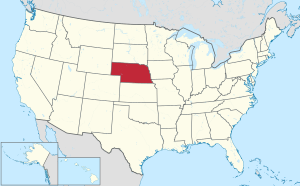Scotts Bluff County, Nebraska
Scotts Bluff County | |
|---|---|
 Location within the U.S. state of Nebraska | |
 Nebraska's location within the U.S. | |
| Coordinates: 41°51′N 103°43′W / 41.85°N 103.71°W | |
| Country | |
| State | |
| Founded | 1888 |
| Seat | Gering |
| Largest city | Scottsbluff |
| Area | |
| • Total | 746 sq mi (1,931 km2) |
| • Land | 739 sq mi (1,915 km2) |
| • Water | 6 sq mi (16 km2) 0.83% |
| Population (2000) | |
| • Total | 36,951 |
| • Density | 50/sq mi (19/km2) |
| Time zone | UTC−7 (Mountain) |
| • Summer (DST) | UTC−6 (MDT) |
| Website | www |
Scotts Bluff County is a county located in the U.S. state of Nebraska. As of 2000, the population was 36,951, making Scotts Bluff the 6th-largest county (by population) in Nebraska. Its county seat is GeringTemplate:GR and its largest city is Scottsbluff.
In the Nebraska license plate system, Scotts Bluff County is represented by the prefix 21 (it had the twenty-first-largest number of vehicles registered in the county when the license plate system was established in 1922).
The county is named after a prominent bluff that served as a monument for 19th-century pioneers traveling along the Oregon Trail. The bluff was named after a fur trapper named Hiram Scott who died near the bluff in 1828. The bluff is now managed by the National Park Service as Scotts Bluff National Monument. The town of Gering was founded at the base of the bluff in 1887, and the city of Scottsbluff was founded across the North Platte River from the bluff in 1900. Separated only by the river, the two cities have since grown together and now form the 7th-largest urban area in Nebraska.
Scotts Bluff County Airport (BFF) is the third busiest airport in Nebraska in terms of passenger boardings.
The economy of Scotts Bluff County is based on agriculture, with the primary crops being sugar beets, corn, and beans.
Geography
According to the U.S. Census Bureau, the county has a total area of 746 square miles (1,931 km²), of which, 739 square miles (1,915 km²) of it is land and 6 square miles (16 km²) of it (0.83%) is water.
Adjacent counties
- Sioux County, Nebraska (North)
- Box Butte County, Nebraska (Northeast)
- Morrill County, Nebraska (East)
- Banner County, Nebraska (South)
- Goshen County, Wyoming (West)
National protected area
Demographics
| Scotts Bluff County Population by decade | |
|
1890 - 1,888 | |
As of the censusTemplate:GR of 2000, there were 36,951 people, 14,887 households, and 10,167 families residing in the county. The population density was 50 people per square mile (19/km²). There were 16,119 housing units at an average density of 22 per square mile (8/km²). The racial makeup of the county was 87.58% White, 0.27% Black or African American, 1.88% Native American, 0.57% Asian, 0.04% Pacific Islander, 8.02% from other races, and 1.63% from two or more races. 17.19% of the population were Hispanic or Latino of any race. 39.5% were of German, 8.6% English and 6.8% Irish ancestry according to Census 2000.
There were 14,887 households out of which 31.50% had children under the age of 18 living with them, 54.20% were married couples living together, 10.70% had a female householder with no husband present, and 31.70% were non-families. 27.80% of all households were made up of individuals and 12.80% had someone living alone who was 65 years of age or older. The average household size was 2.44 and the average family size was 2.97.
In the county the population was spread out with 25.90% under the age of 18, 8.40% from 18 to 24, 25.40% from 25 to 44, 23.00% from 45 to 64, and 17.20% who were 65 years of age or older. The median age was 38 years. For every 100 females there were 91.20 males. For every 100 females age 18 and over, there were 88.30 males.
The median income for a household in the county was $32,016, and the median income for a family was $38,932. Males had a median income of $30,317 versus $20,717 for females. The per capita income for the county was $17,355. About 11.00% of families and 14.50% of the population were below the poverty line, including 22.00% of those under age 18 and 8.70% of those age 65 or over.
Cities and villages
41°51′N 103°43′W / 41.85°N 103.71°W

